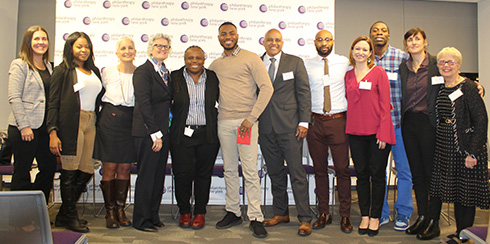Categories:
12.30.2017
NY philanthropies hear from young adults, providers and government about challenges to accessing stable housing.

Representatives from more than a dozen philanthropies came together on December 12th to hear from providers, young adults, and representatives from city government about the challenges young adults who are transitioning from foster care face in terms of finding and keeping housing. Part two of a series “Helping Foster Youth Succeed,” the panel was organized by the NYC Youth Funders (Katie Napolitano of the Tiger Foundation and Natasha Lifton of New York Community Trust spearheaded the event) and took place at Philanthropy New York. The panel was moderated by the Network’s Executive Director Laura Mascuch, and included Denise Hinds of Good Shepherd Services, Jeremy Kohomban of Children’s Village, Liz Northcutt of City Living NY, Maryanne Schretzman of the Director of NYC Center for Innovation through Data Intelligence, and Judi Trotter of the Administration for Children’s Services, as well as three former foster youth -- Hasani Callwood, Jahlika Hamilton, and Maurice Reid.
Katie Napolitano introduced the panelists, and Maryanne Schretzman framed the panel with an overview of the research on foster youth, including the trajectories of transition age youth and the impacts of various systems on housing stability. Liz Northcutt discussed ways City Living NY has worked with youth to navigate the application to and maintenance of affordable housing once young people leave foster care. Judi Trotter discussed the promising practices of ACS: its Housing Academy; a new program that pays for transitioning youth’s expenses while in college; and the requirement that caseworkers help youth apply to both NYCHA and supportive housing as they leave foster care. Jeremy Kohomban showcased programming at The Children’s Village and the demographics and needs of young people in the foster care system.
As always, it was the young adults who were the stars of the afternoon. Hasani Callwood, who had lived at Good Shepherd Services’ Chelsea Foyer and had recently moved to independent housing, spoke about his difficulties adjusting to the rent differentials. At Foyer, he paid a set amount that was put into a savings account for him to use once he left the program; now that he lives in an independent apartment with the help of rental subsidy, his rent is calculated at 30% of his gross income. Both Maurice Reid, formerly with Children’s Village, and Jahlika Hamilton strongly agreed that this rent calculation – and their unpreparedness for the stark impact it had on their ability to maintain housing – had presented major difficulties. While the 30% standard for rent payment is typical across Section 8, NYCHA and supportive housing, these youth were expecting to pay 30% of their take-home pay, not 30% of their before-tax gross income. When incomes are low, the difference between those two calculations can be large and have serious implications on a household budget. Maurice told of Children’s Village’s advocacy on his behalf when he was turned down for public housing, a fight that took three years to resolve. Jahlika had everyone in tears when she told attendees about the difference City Living had made in her life by painting and decorating her ‘prison grey’ NYCHA apartment one weekend. All three addressed NYCHA’s requirement that applicants choose a borough as part of their housing application, leading some to have to turn down apartments because they were located in neighborhoods the young people were trying to escape.
Natasha Lifton wrapped up the intense conversation by noting that there were some clear policy issues raised that afternoon that philanthropy could address, while Maryann Schretzman noted the same could be said about policies the city controlled.
